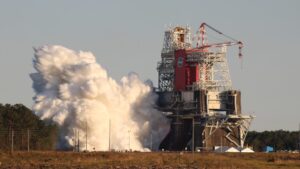By Jeff Foust

WASHINGTON — NASA will carry out a second hotfire test of the Space Launch System core stage, a move that makes it more likely the vehicle will miss its scheduled launch date of late this year.
NASA announced late Jan. 29 that it will re-run the static-fire test of the core stage’s four RS-25 engines no earlier than the final week of February at the Stennis Space Center in Mississippi. That test is the last step in the Green Run test campaign that started one year ago.
The agency decided to perform a second test after the initial hotfire test Jan. 16 ended after just 67 seconds, far short of the planned 485 seconds. NASA said three days later that the hydraulic system on Engine 2 hit “intentionally conservative” limits, triggering a shutdown by the flight computer.
For the upcoming test, engineers will be “updating conservative control logic parameters that resulted in the flight computer ending the first hot fire test earlier than planned,” NASA said. They had already replaced an electrical harness that triggered a “major component failure” warning in Engine 4 during the test, but which involved redundant instrumentation not linked to the early end of the test.
The upcoming test will last “approximately at least 4 minutes,” although the goal remains to perform a full-duration test. Before the first static-fire test, officials with NASA and Boeing, the SLS prime contractor, said they would collect most of the data they needed if the test lasted about 250 seconds, or a little more than four minutes.
At a Jan. 19 briefing about the test, agency officials suggested it might be possible to continue with preparations for the Artemis 1 launch without a second hotfire test, despite falling short of the required duration. “You have to understand the risk of exposing the flight core stage to another round of tests, and how does that risk trade off with the learning that we need to do,” Kathy Lueders, NASA associate administrator for human explorations and operations said.
The core stage, though, may be more robust than they thought. At that briefing, then-NASA Administrator Jim Bridenstine said that the core stage was designed to be loaded with cryogenic propellants, liquid hydrogen and liquid oxygen, only nine times. With two of those fuelings already used for the hotfire test and an earlier wet dress rehearsal, an additional static-fire test would cut into the margin used for tests at the Kennedy Space Center and launch attempts.
However, NASA said Jan. 21 that the core stage is, in fact, rated for 22 fueling cycles, with nine of them reserved for the Green Run test campaign.
In its announcement of the static-fire test, NASA did not state what affect the extended test campaign would have on the schedule for the Artemis 1 launch, currently scheduled for November. The second test, though, will delay the delivery of the core stage to KSC by more than a month. NASA said it will take about a month to refurbish the stage after the second hotfire test before shipping it to KSC, a timeframe similar to what the agency said before the first test.
“Our team is locked in and focused on delivering the rocket for a 2021 launch. We’re continuing to look for opportunities to do things concurrently and improve our schedule,” John Honeycutt, SLS program manager at NASA, said before the first test.
However, even before the Jan. 16 test they acknowledged there was “very little margin” in the schedule for a November 2021 launch.
January 30, 2021 at 04:55AM
via SpaceNews read more...

0 Comments